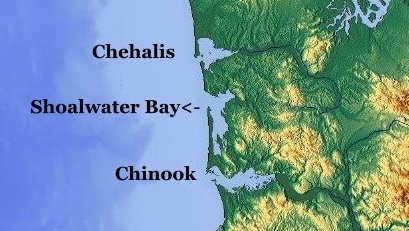
Shoalwater Bay Homeland and Territory.
Shoalwater (and Willapa) Bay lands and territory were located in the middle of two very prominent cultural and linguistic groups: the Lower Chehalis and Chinook. Other than two major peoples, the Shoalwater Bay was home to unique linguistic and cultural communities who intermingled, traveled, and made their homes on the bay as well. As a result, on the shores of Shoalwater Bay various indigenous peoples, most prominently Chinook and Lower Chehalis, represent the merging of these peoples through intermarriage, heavy trade, and constant interactions for many hundreds of years.
Shoalwater Bay Tribal members are descendants of a mixture of Coastal Salish and Chinook ancestors, called Lower Chehalis and Lower Chinook; both lived and interacted along the Pacific Coast in what is today Southwestern Washington and Northern Oregon.
The Columbia River, Willapa, and Shoalwater Bay Peoples:
The lower Columbia River was the main focus of Lower Chinook life, resources, trade relations, language, and culture. Additionally, Chinooks were also drawn to the river areas and resources, such as oysters, of Shoalwater Bay (later named Willapa Bay). Bay Center near the Willapa River is a good example. The Shoalwater/Willapa Bay also provided a winter refuge for many Columbia River Chinook as well as providing an important seasonal resource area for several village communities, including the Lower Chehalis and Chinook most prominently, throughout the region.
The Chinook peoples were often more accustomed to the lifestyle of a major river like the Columbia and the Lower Chehalis, though neighbors, preferred the sandy bay areas and ocean front locations. The large village of Tshels (Tse-ha-lis, later Anglicized as Chehalis) was such a place, giving its name to the people and the ancient location, a place very close to the Grays Harbor ocean front town of Westport, Washington. Tse-ha-lis was a sandy coastal location with a lifestyle to match the environment, characteristics that went on to define an entire people and resource area, language, and culture. The Lower Chehalis community of Tse-ha-lis were similar in that way to various areas on Shoalwater/Willapa Bay at Namscac, North Cove, and Tokeland.
How Indigenous People of the Region Explained their Homelands and Territories:
Indigenous people of Shoalwater Bay often described themselves to others by referencing their specific village or town location. People from Chehalis for instance would identify themselves as Tse-ha-lis in the same way that community members from the large town of Chinook near the mouth of the Columbia River did so. Occupation and the nature of the lands indigenous people lived and worked on, such as a sandy location, a prominent resource area, or a river also helped to describe themselves, and their status was also usually apparent in most interactions.
Central to their identity was the primary village they called home, and the resource areas that the village or town managed, usually near or adjacent to several longhouses that made up the indigenous community’s living arrangements. This allowed villages near resource locations to host many other communities when needed, such as in-laws, and trade partners, public ceremony participants, for interactions, celebrations, and a chance to return the favor when the occasion came up.
Neither group confined themselves to one type of location and freely interacted, formed financial partnerships, made their homes, intermarried, and shared trade relationships and managed resource areas on behalf of the community, usually following seasonal travel as various resources and trade goods became available.